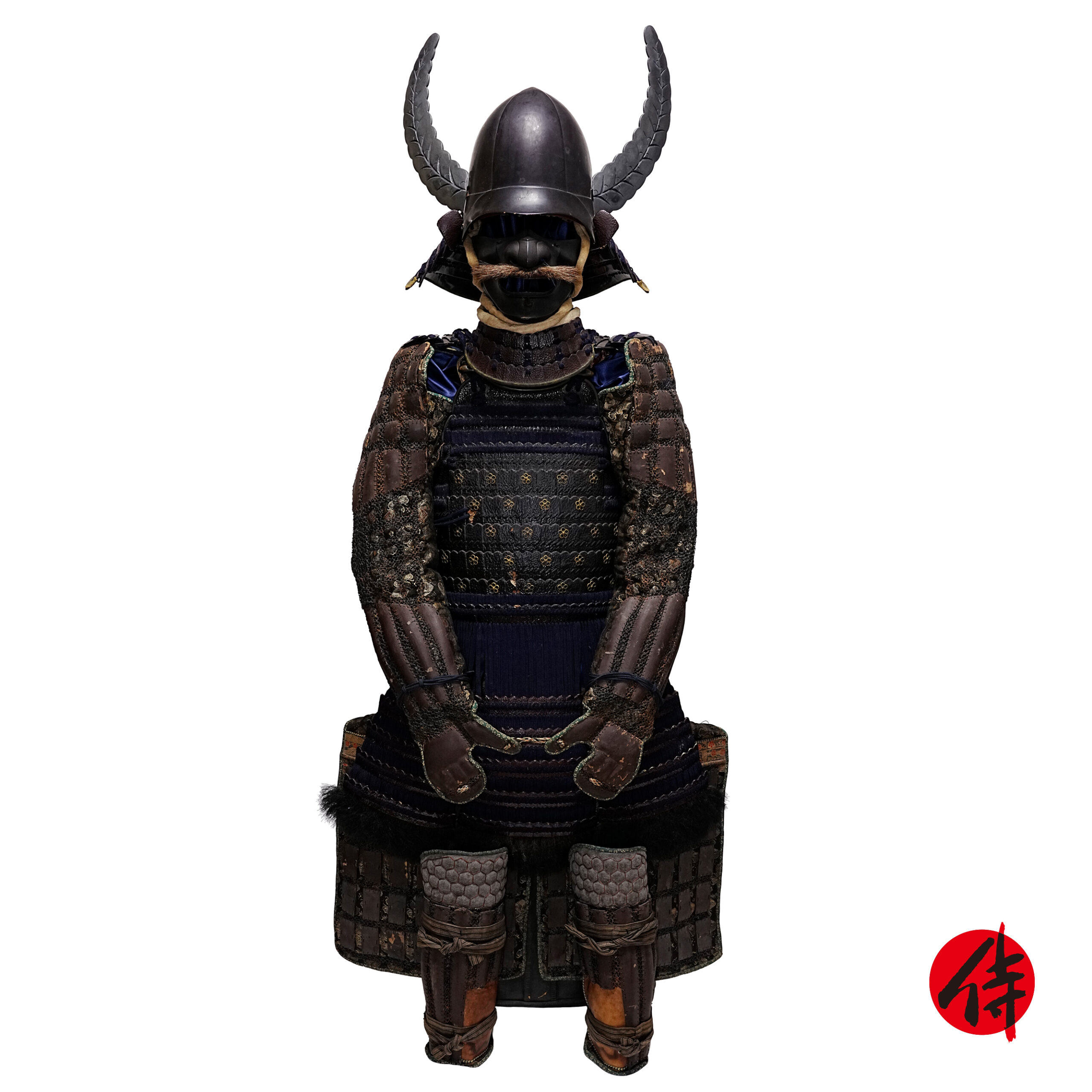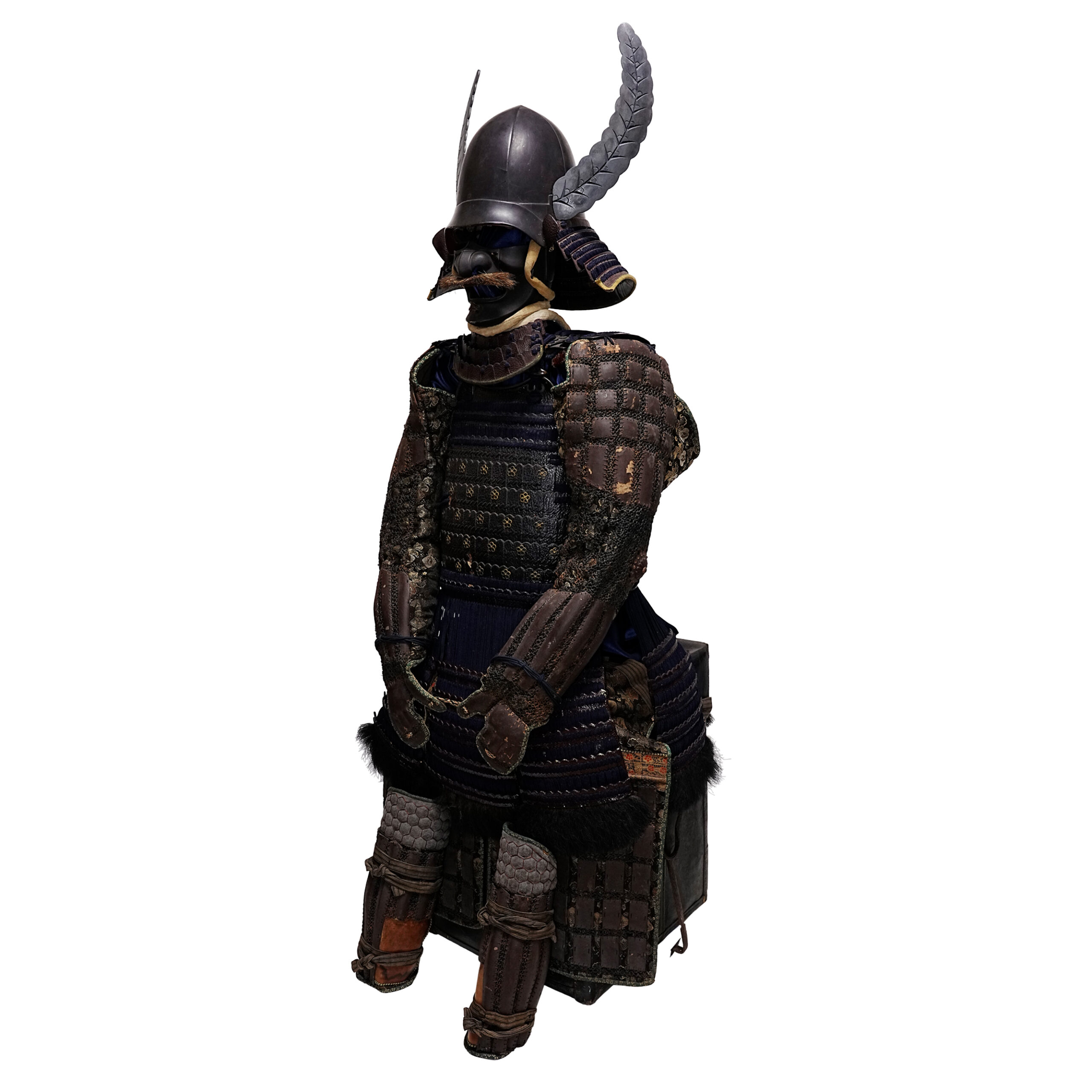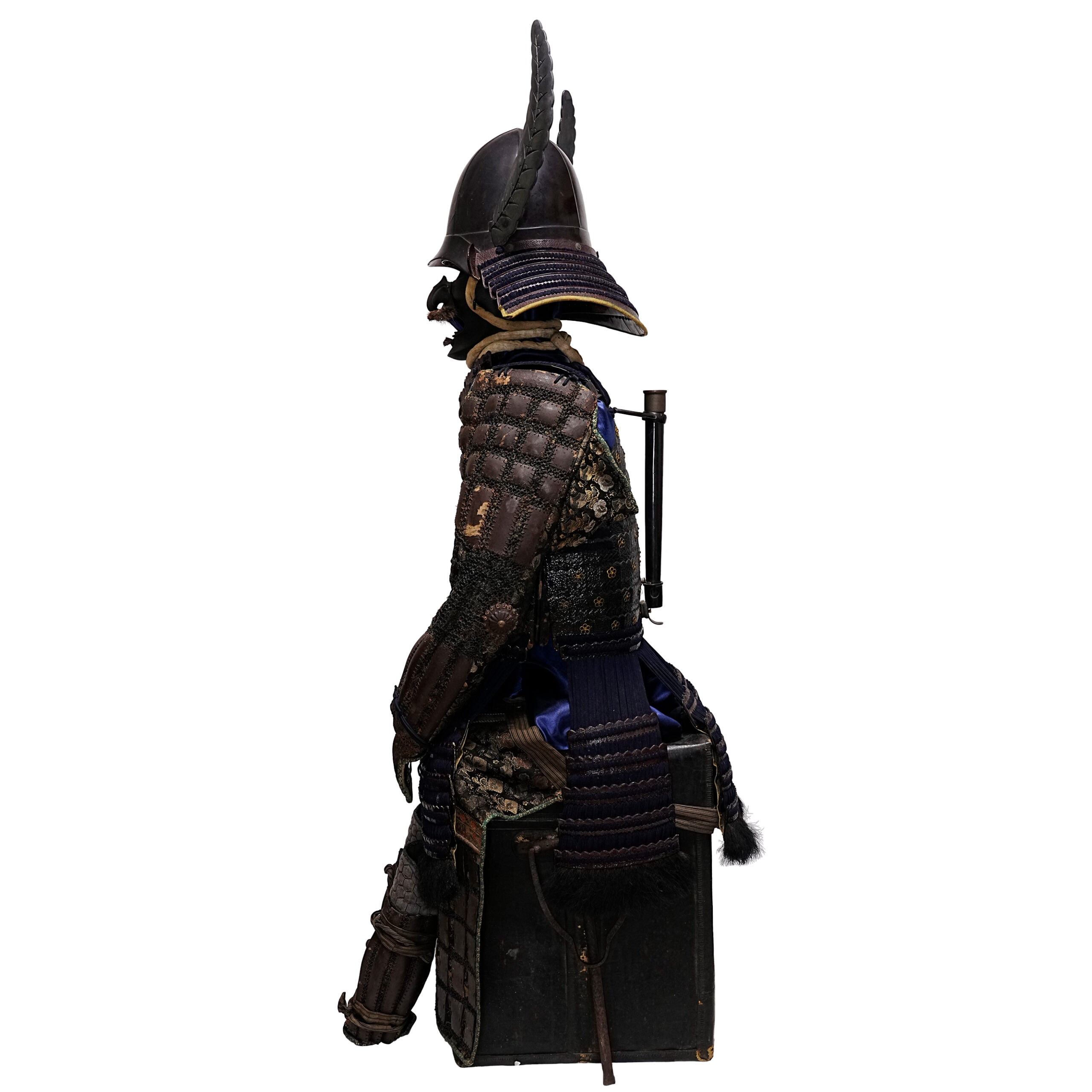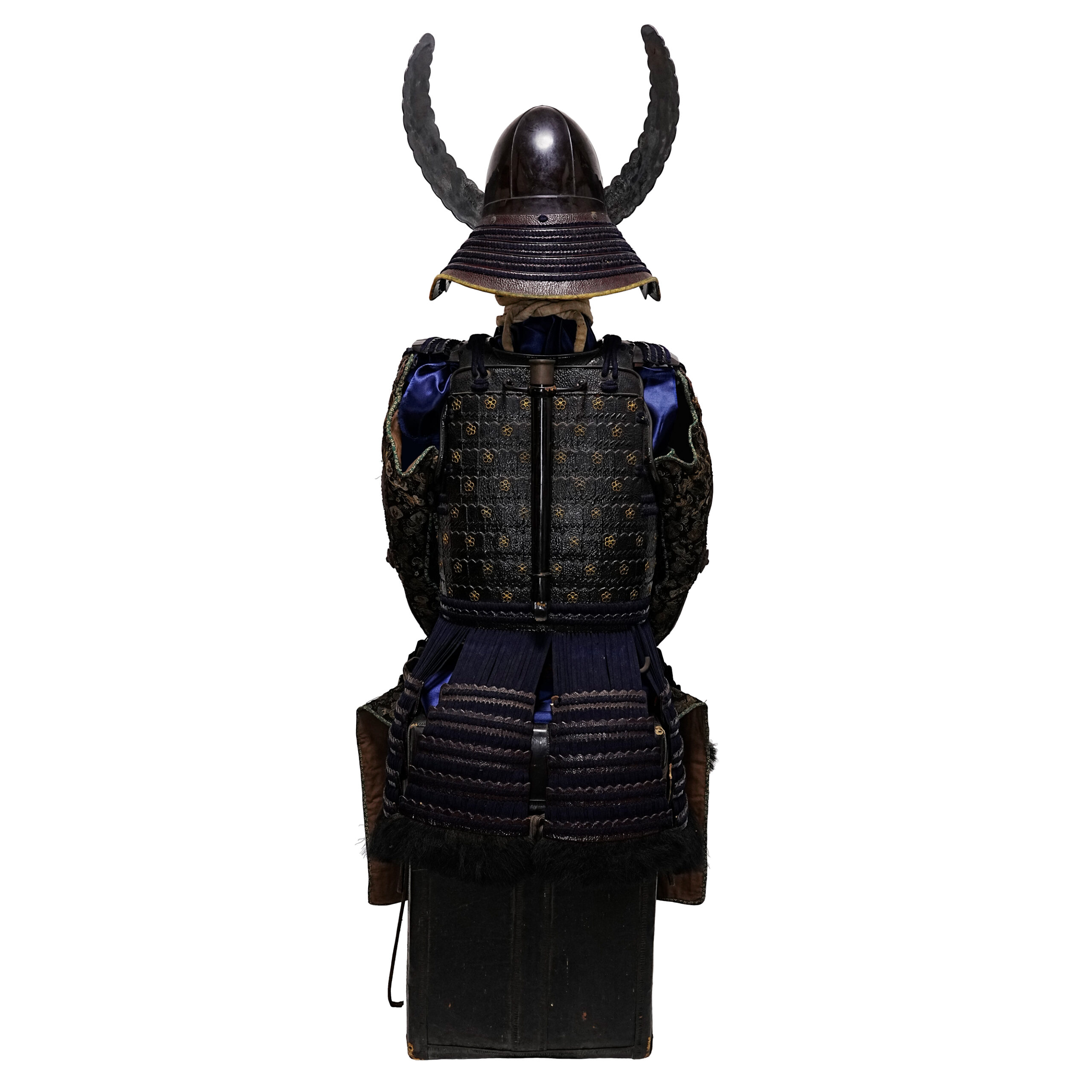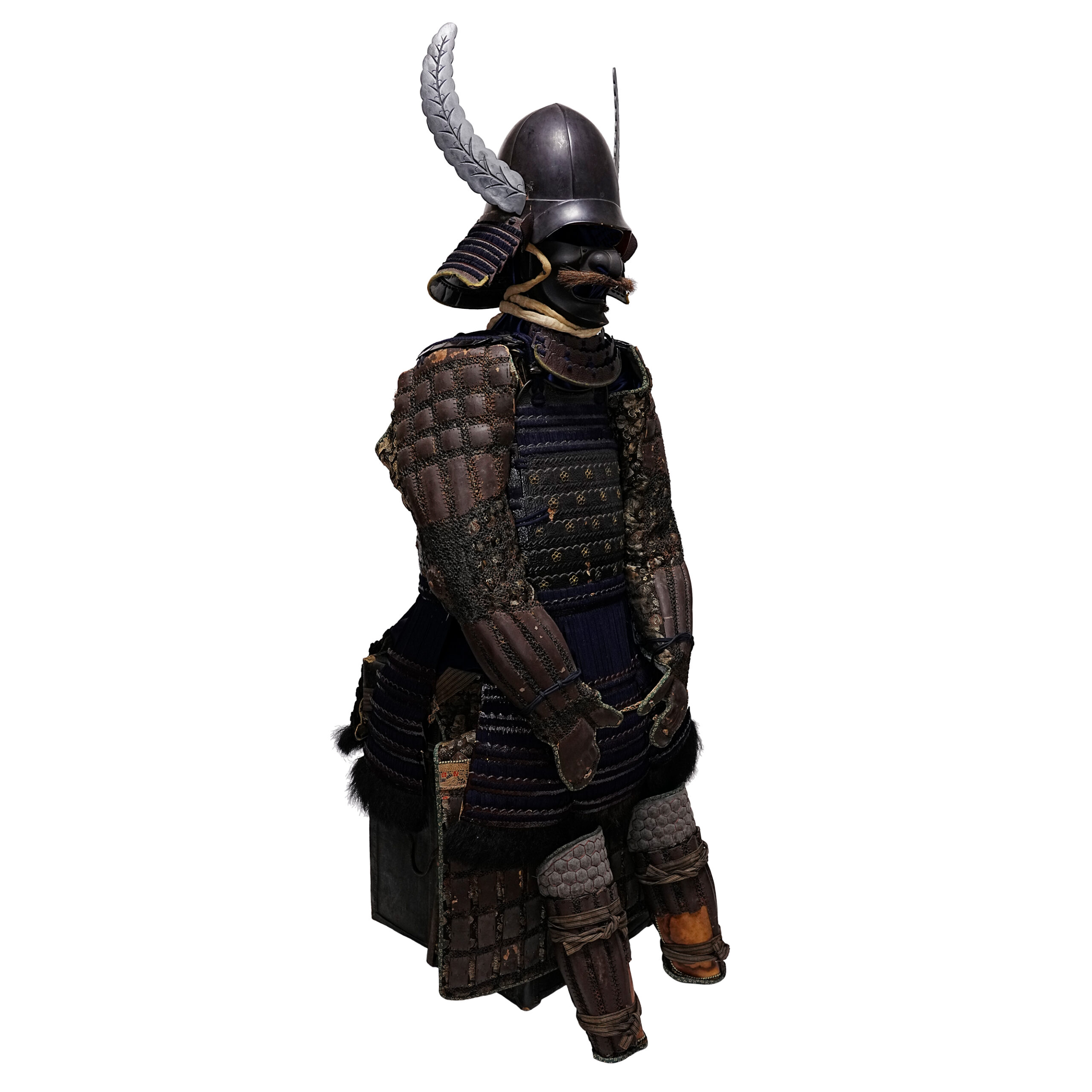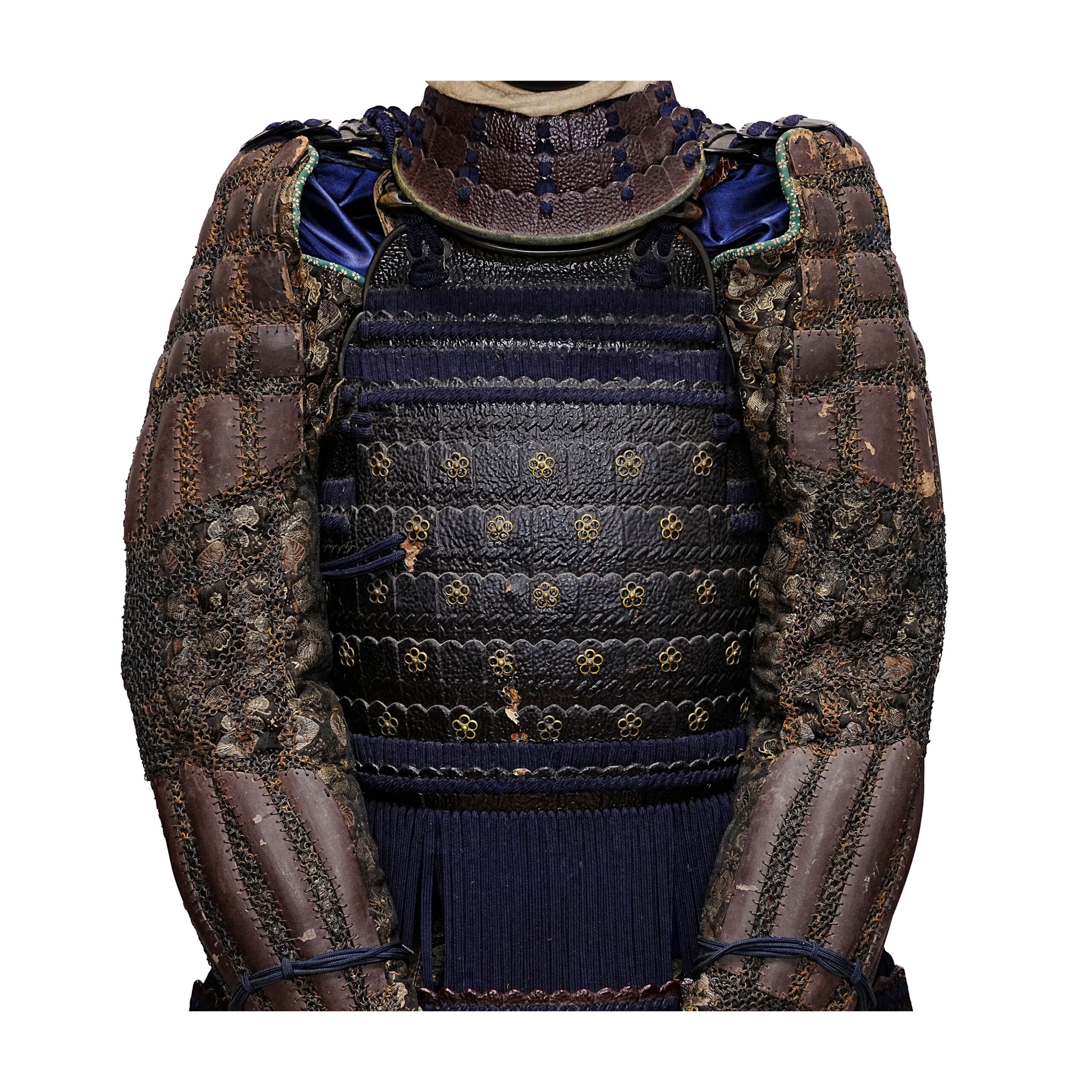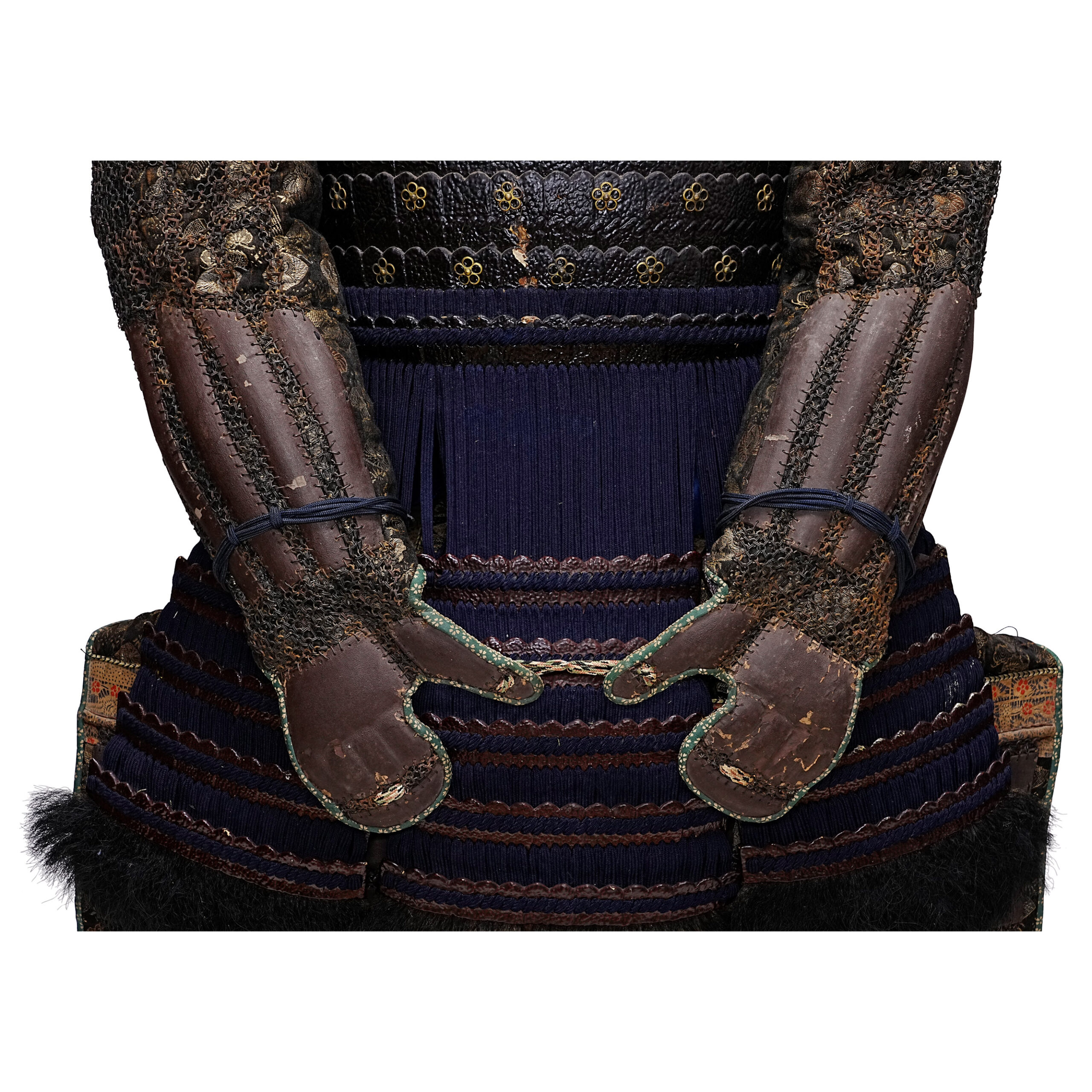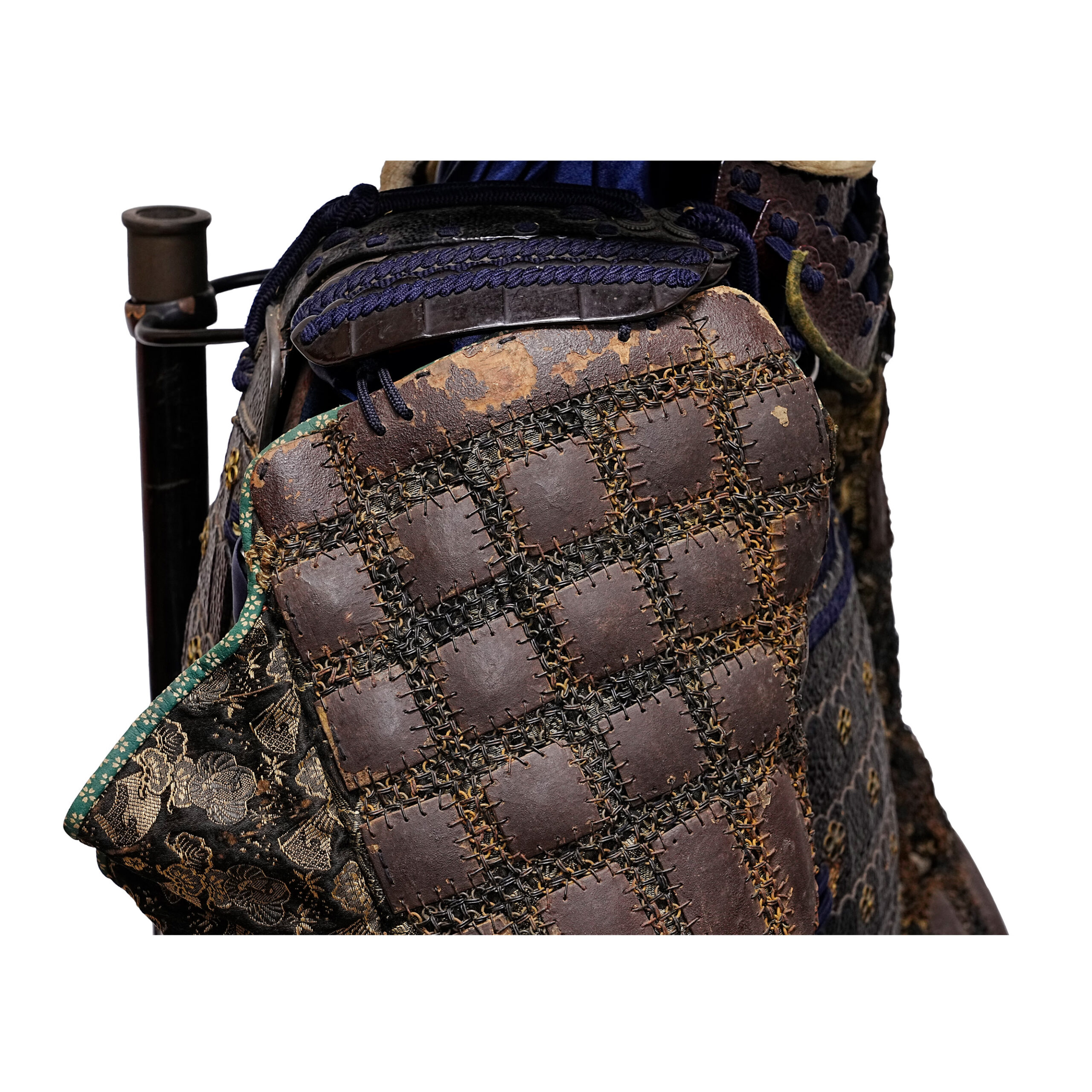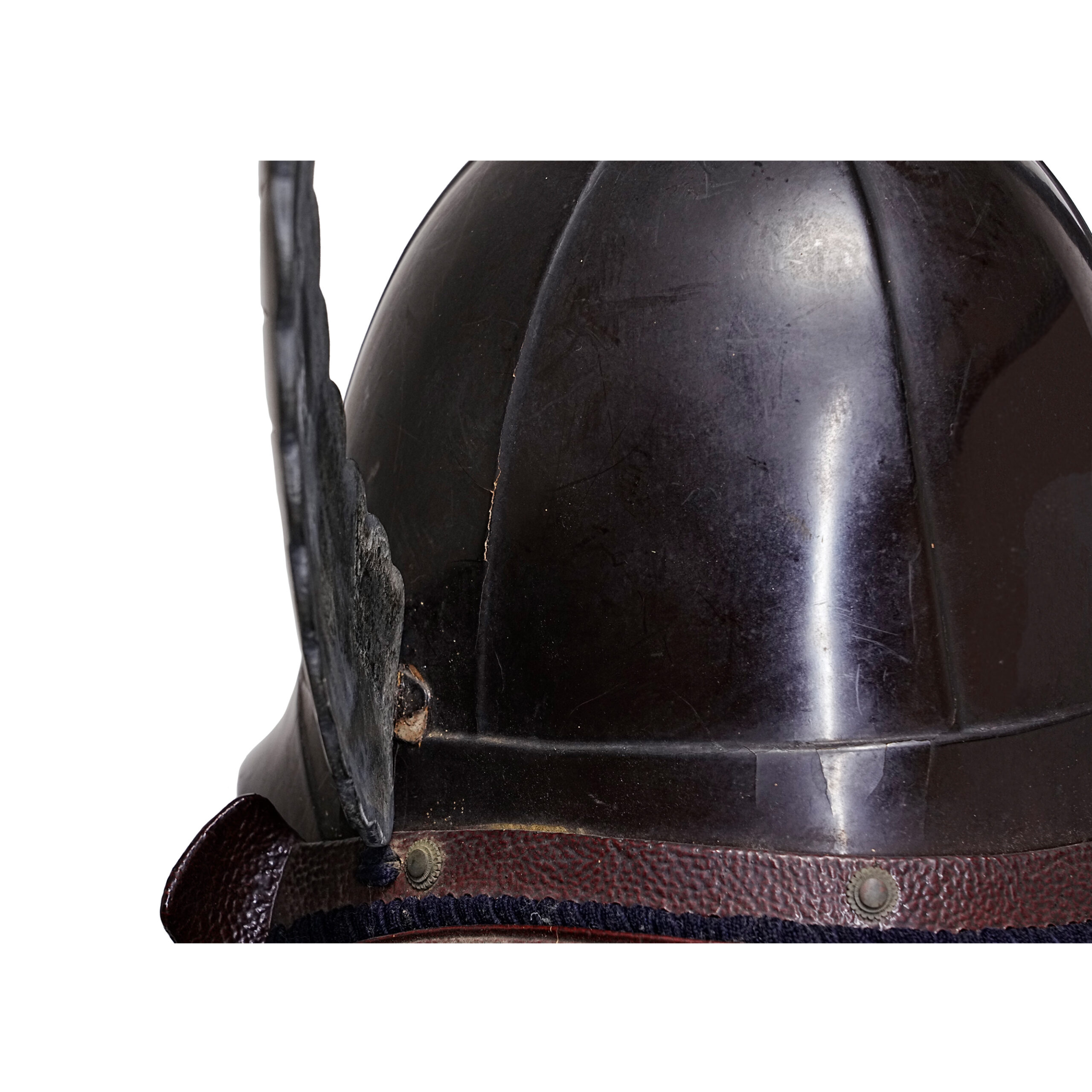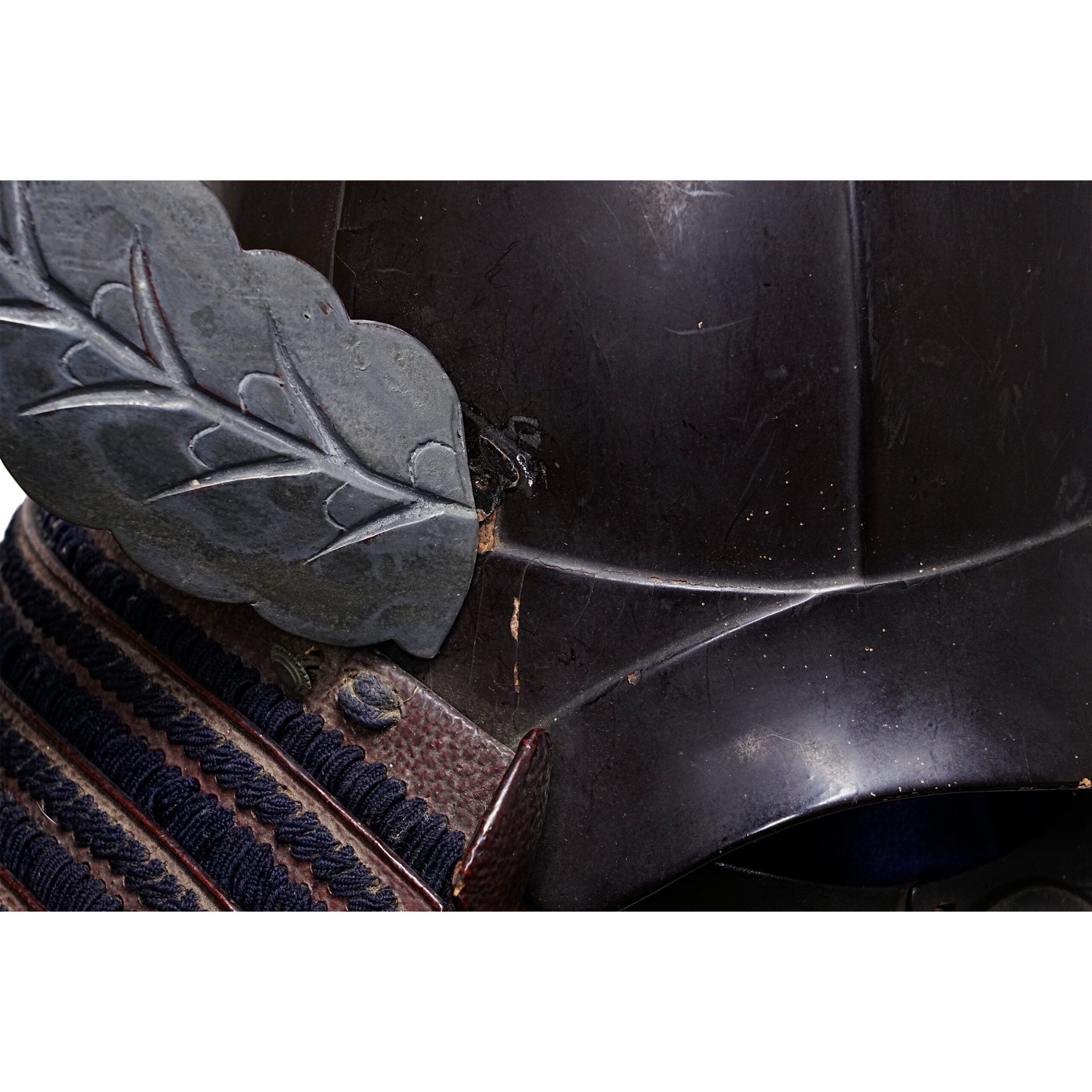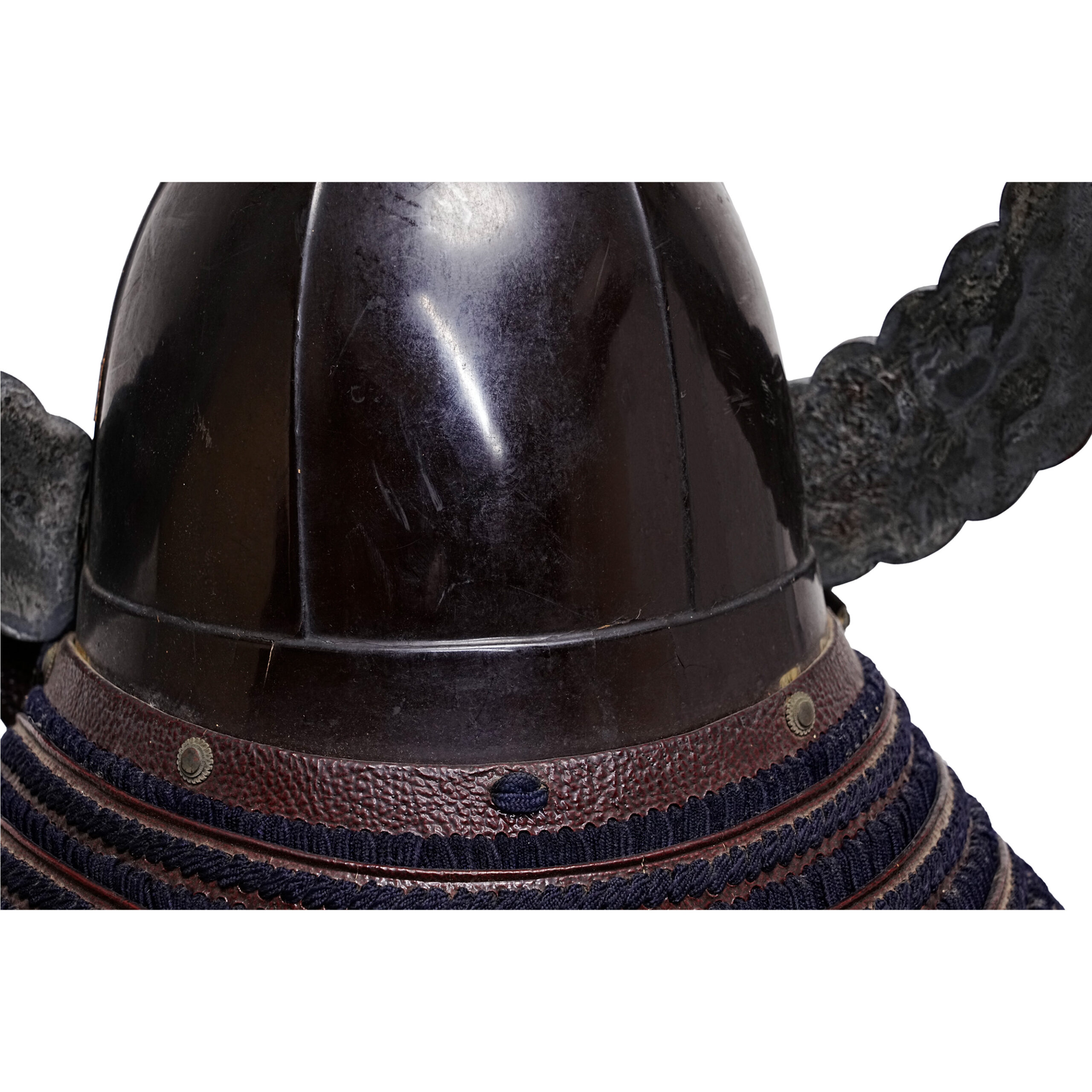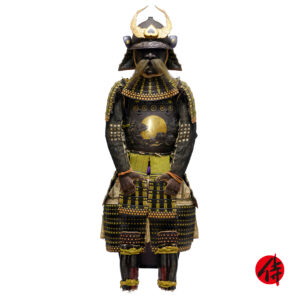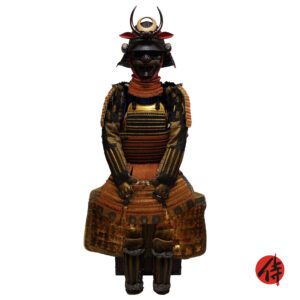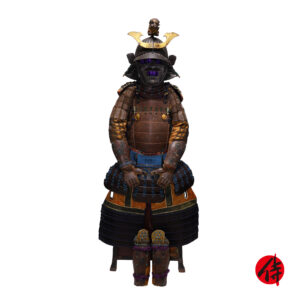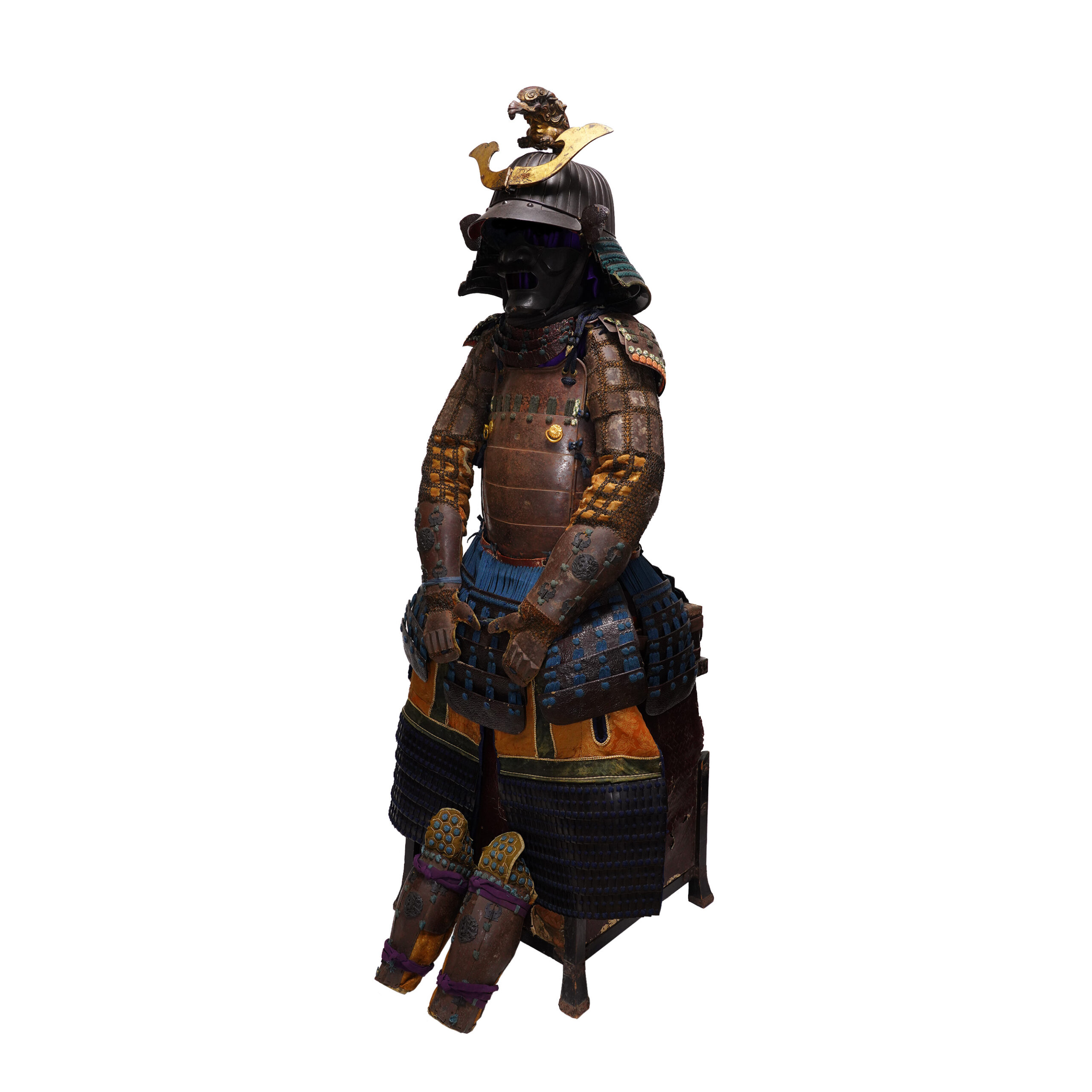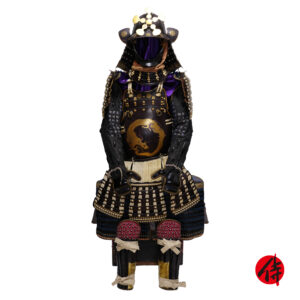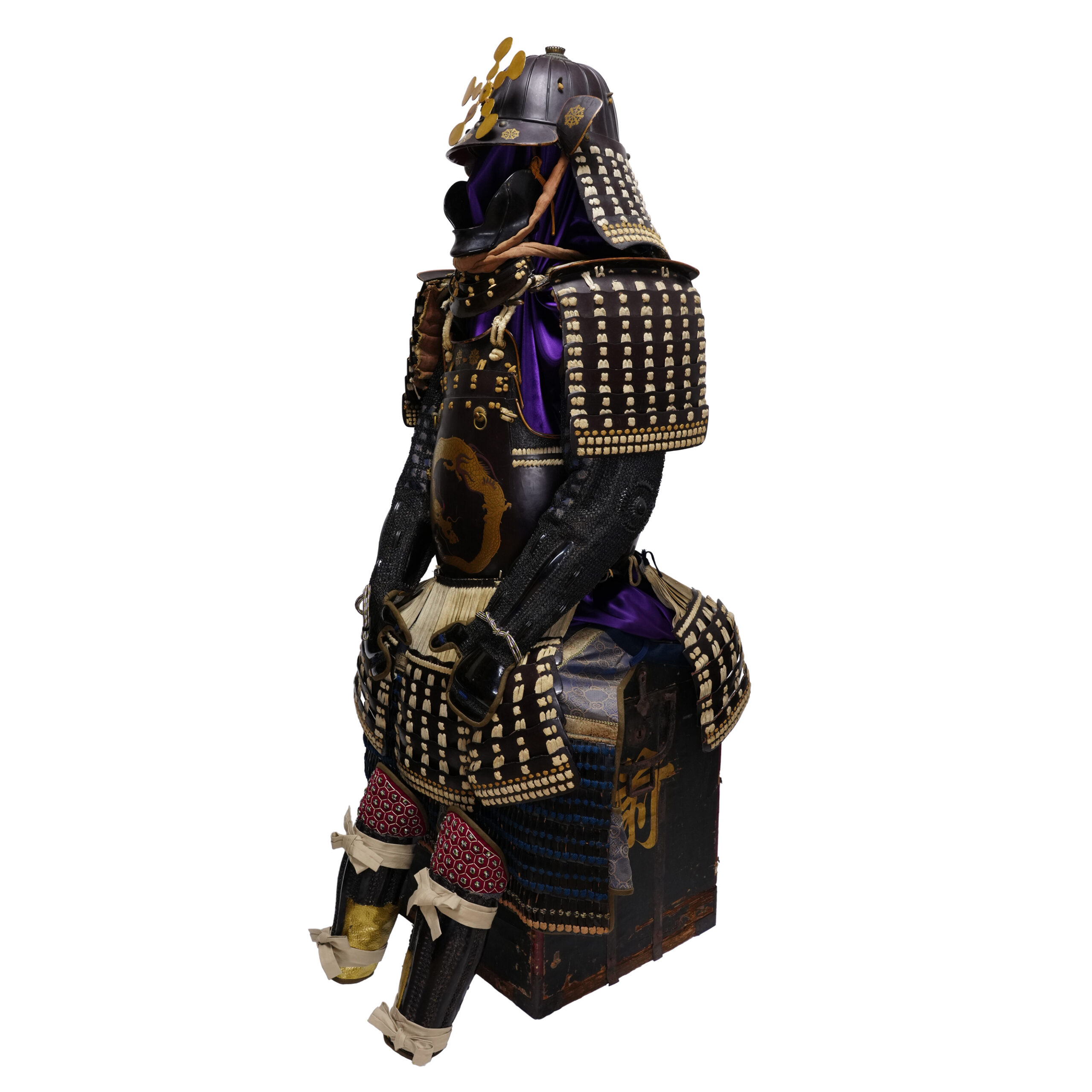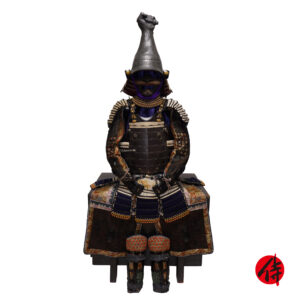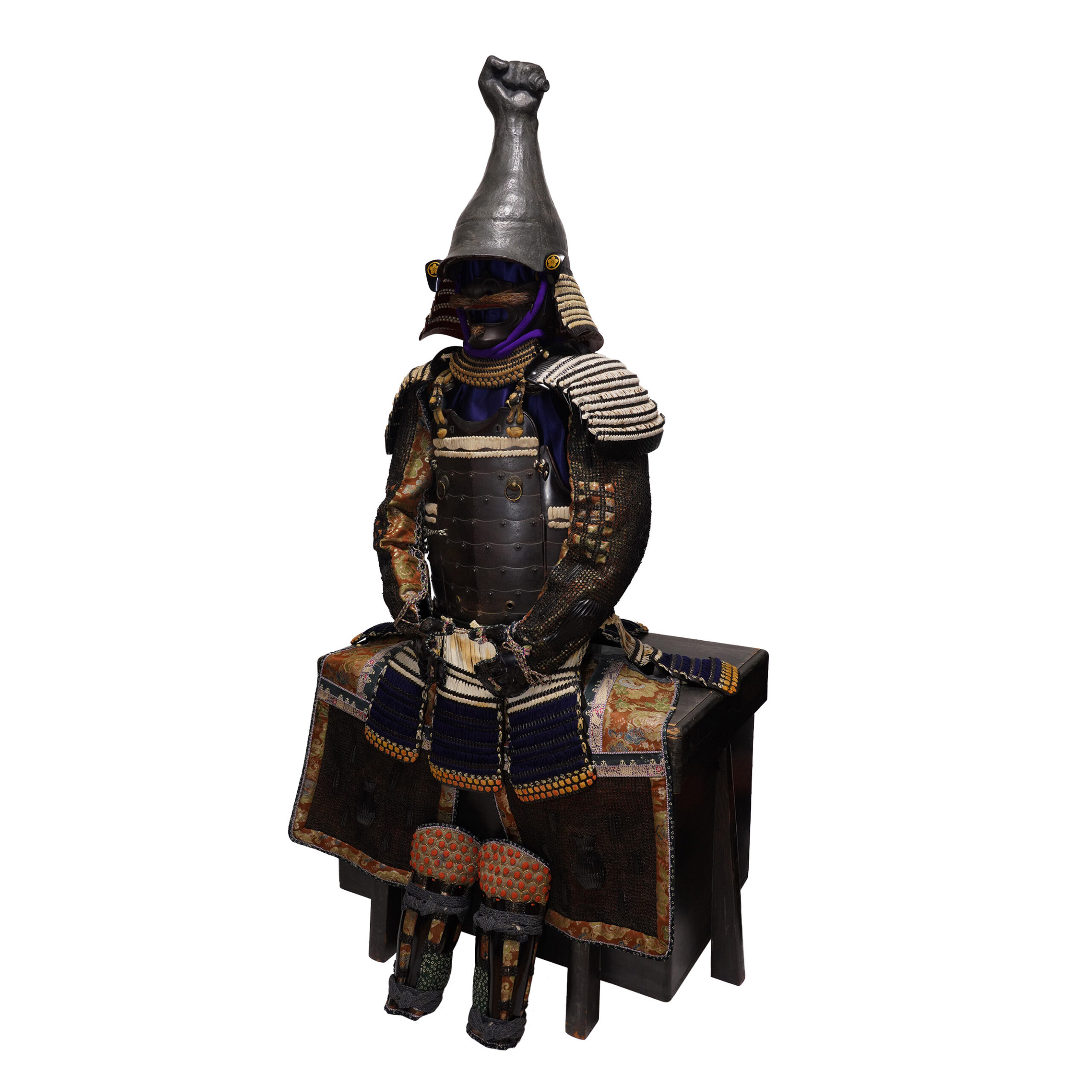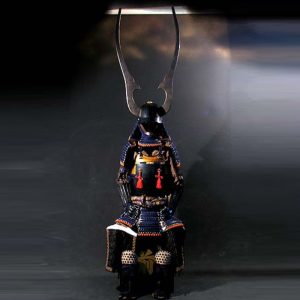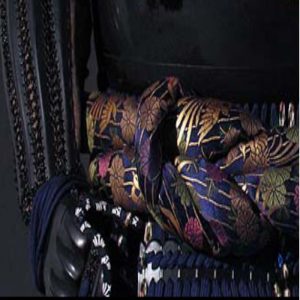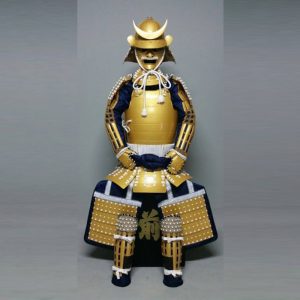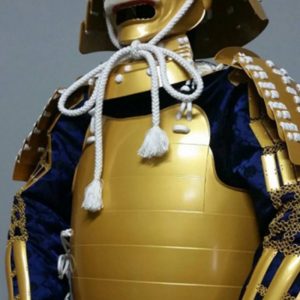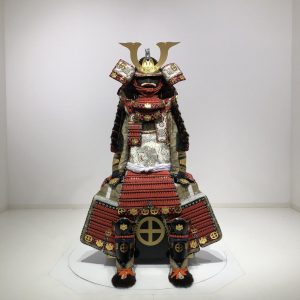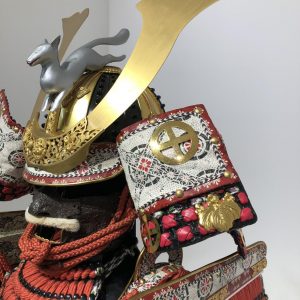Antique Early Edo Period Samurai Armor Tokubetsu Kicho Shiryo Certificate (A-34)
Period: the early Edo Period
appraised by The Association for the Research and Preservation of Japanese Helmets and Armor
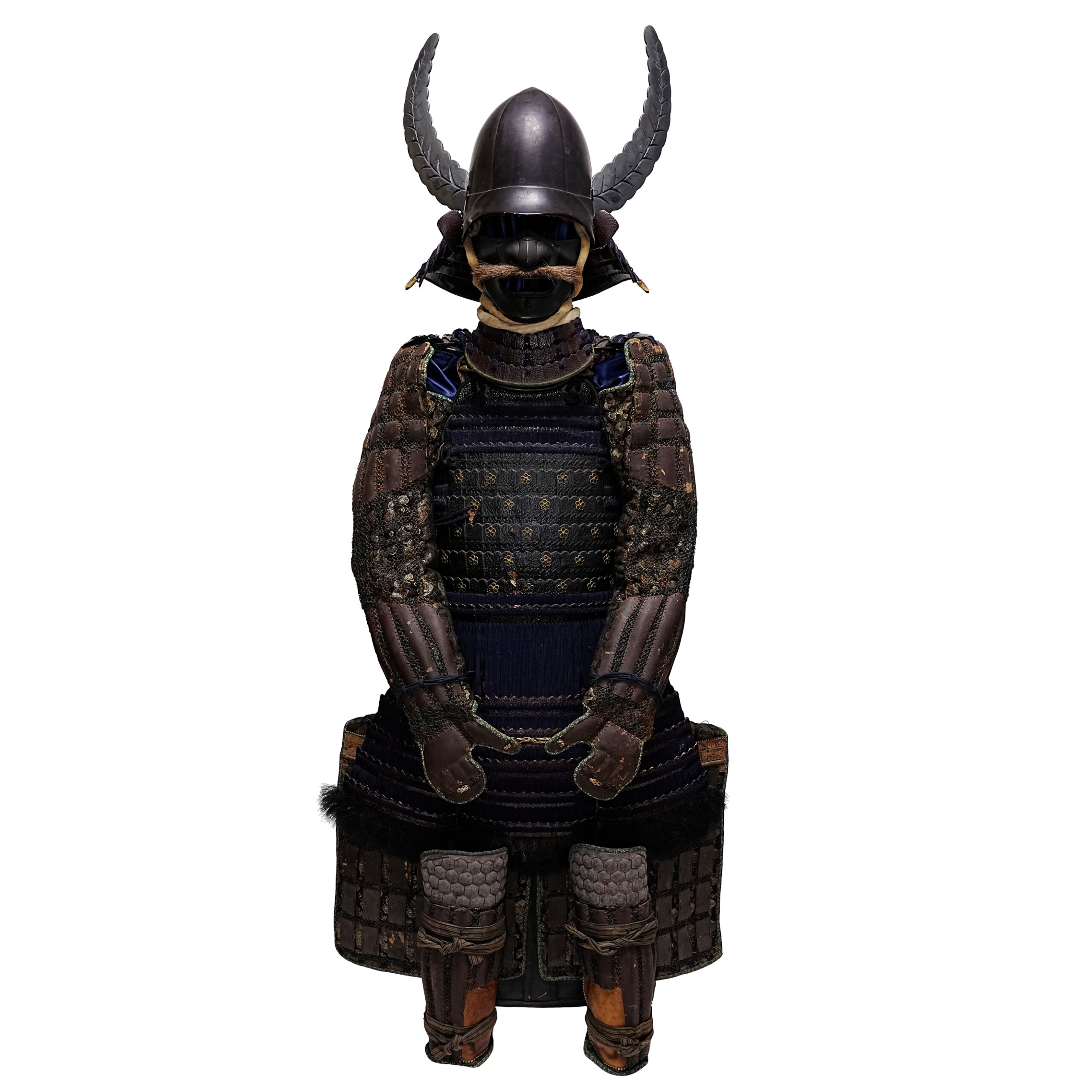
Kabuto (helmet)
■Helmet bowl: Momonari Kabuto
The Kabuto (兜, helmet) is a protector for the head. When people started using the Kabuto, it was initially designed for practical use. However, the principal purpose of its design has changed with time; Samurai tried to express their dignity, personality, or religion by wearing the characteristic designed Kabutos. According to a theory, these uniquely designed Kabutos were made from the late Muromachi (室町, 1467-1573) period to the Edo (江戸, 1603-1868) period. This type of Kabuto is categorized as the Kawari Kabuto (変わり兜), and a variety of materials were used to create them. For example, animal fur, seashells, plants, and papers were used as materials for decoration.
We believe this Kabuto is categorized as the Momonari Kabuto (桃形兜). The characteristic of this style of Kabuto is that the top of its head has a peach shape (peach is called the Momo in Japanese). The Momonari Kabuto is a kind of Kawari Kabuto. Compared to the Suji Kabuto (筋兜), the Momonari Kabuto took less time and effort and was suitable for mass production. Therefore, in the beginning, mainly lower-ranked Samurai warriors wore this style of Kabutos as their simple protector. However, after a while, people valued the functionality and beauty of its shape. And even some high-ranked Samurai regularly used the Momonari Kabutos. The smooth surface was expected to deflect attacks from swords, spears, and ammunition and reduce the damage received. In addition, the Momonari Kabuto is relatively light. We think it is also one of the reasons why many Samurai warriors accepted it.


■Shikoro (side neck guard):
Leather plates laced with navy threads.

■Fukikaeshi (side neck guard): Ichimoji Mon
The Fukikaeshi (吹き返し) is both ends of a Kabuto. It protects the face from swords and also shows its beautiful workmanship. Family crests are sometimes designed on this part. The Fukikaeshi of this Kabuto has a simple look.

■Menpo (face guard): Ressei Menpo
This type of Menpo is called the Ressei Menpo (烈勢面頬). It represents the angry face to intimidate enemies. There are many types of Menpo, depending on their shape or appearance. The purpose of Menpo was not only to protect Samurai’s face. But also to hide their true faces so that their psychological states were unaffected. Short beards are attached to this Menpo. Thanks to this effect, even a young soldier would have been able to produce the majestic appearance of a middle-aged Samurai.
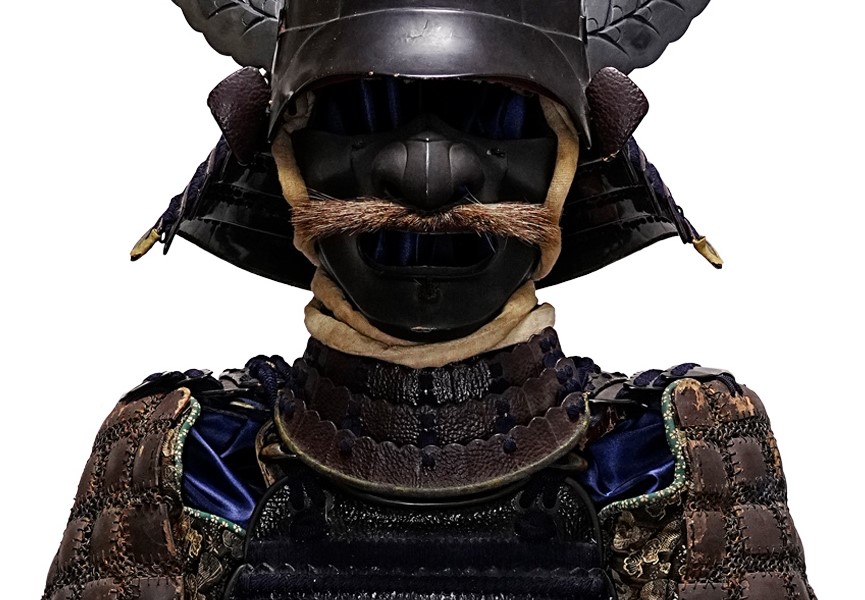
■ Wakidate (side decoration):
Instead of the Maedate (前立, front decoration), the Wakidate (脇立, side decoration) is attached to this Kabuto. These are kinds of Tatemono (立物); it is a general term for items that decorate a Kabuto and show off the wearer’s dignity and exaggerate their presence. The designs included standing objects with motifs of animals, plants, and vessels and Tatemonos rooted in religious beliefs, such as the sun and moon. They were made of various materials, including iron, copper, gold, silver, brass, wood, bamboo, animal horns, tusks, and leather. This decoration is classified as follows depending on where it is attached on a Kabuto: Maedate, Zudate (頭立, ornament attached to the top of the head), Wakidate, and Ushirodate (後立, back decoration). The Wakidate of this Kabuto’s motif is a leaf of some plant. Each leaf has an elongated shape toward the tip, and this symmetrical decoration seems to be an animal’s horn, making this Kabuto look impressive.
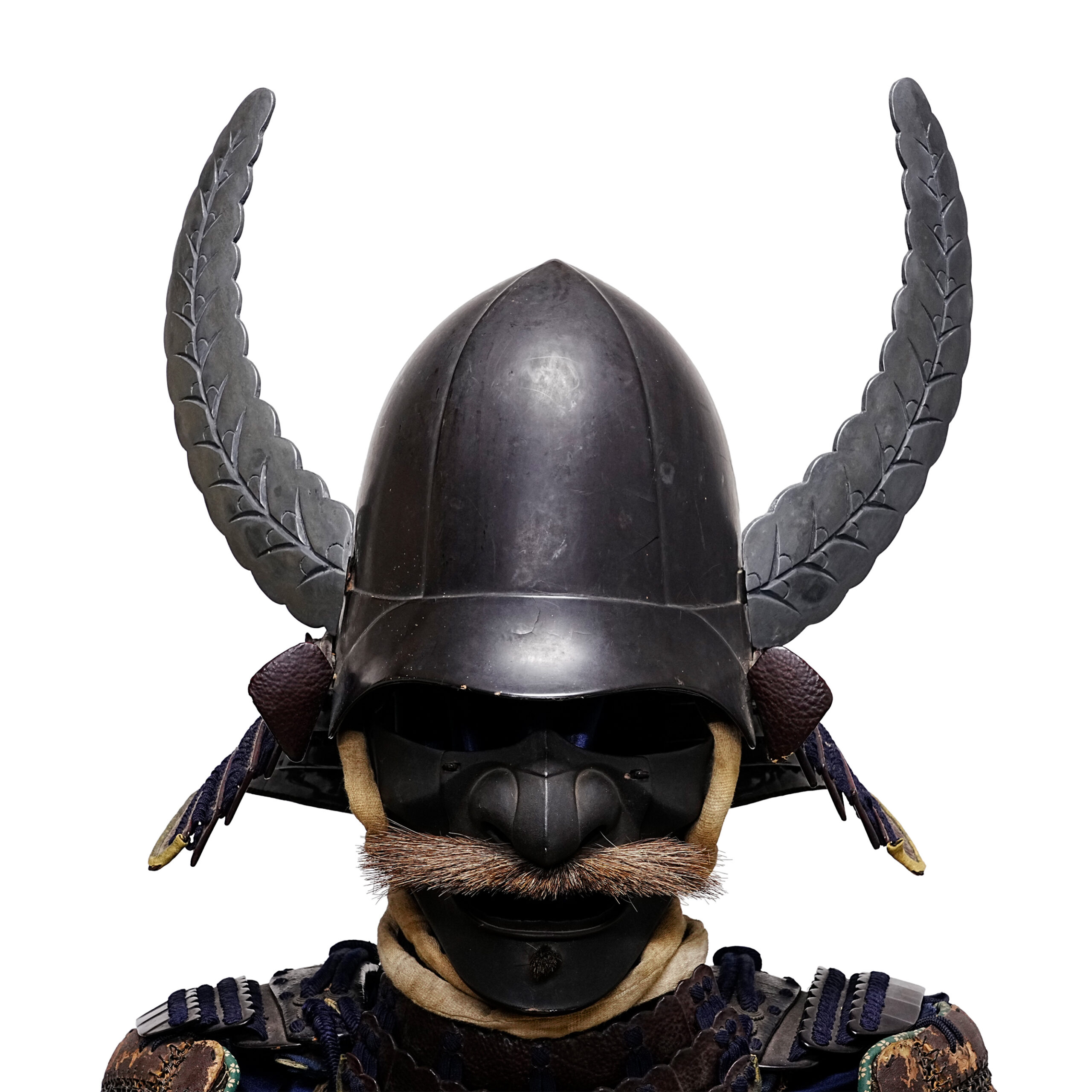
Armor
■Dō (cuirass): Nimai Dō
The Nimai Dō (二枚胴) is a kind of cuirass for the Tousei Gusoku (当世具足, developed armor style). The Nimai Dō was named because Nimai (二枚) means two plates and Dō (胴) means torso in Japanese. Instead of using many small lamellar plates called Kozane (小札), this cuirass used large iron plates riveted.
■Kusazuri (skirt of plates attached to the cuirass):
Lacquered iron Kusazuri laced with navy threads. The cords for the Odoshi (縅, a technique for armor tying boards together with cords such as leather or thread) are relatively in good condition, so each plate is tied without coming off.
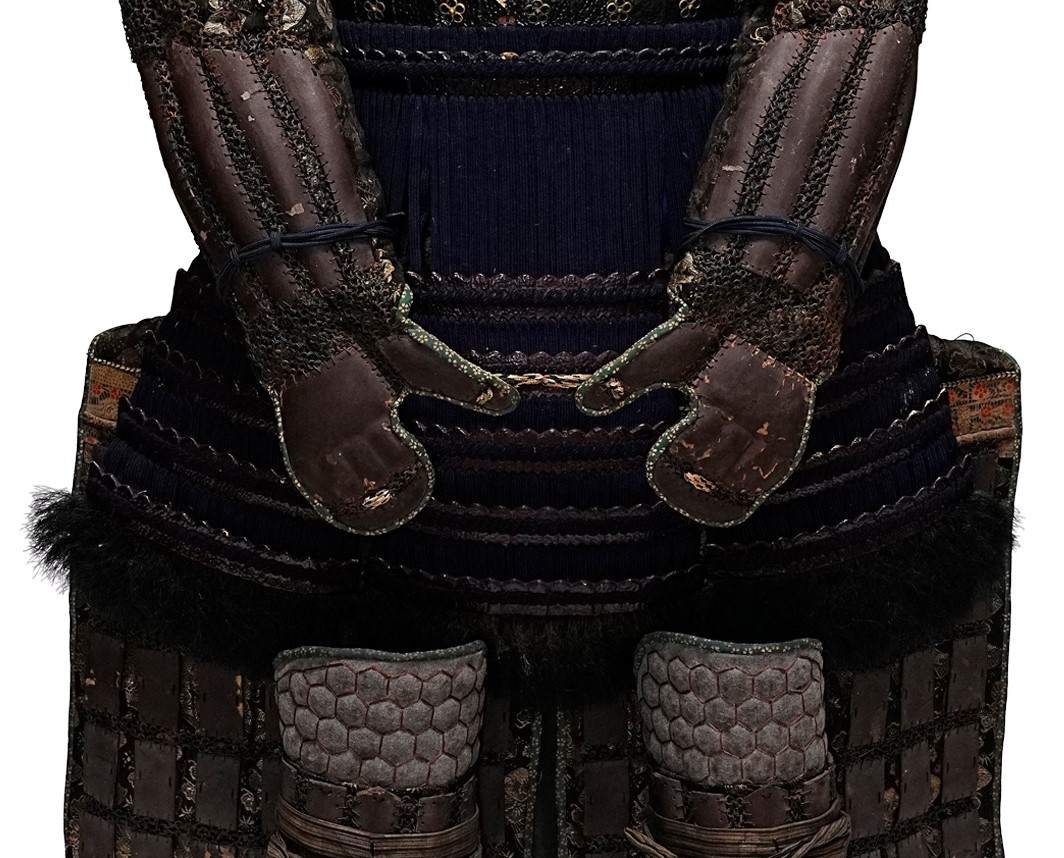
Small parts
■Kote (armored sleeves):
Intricate iron chain mail with silk.
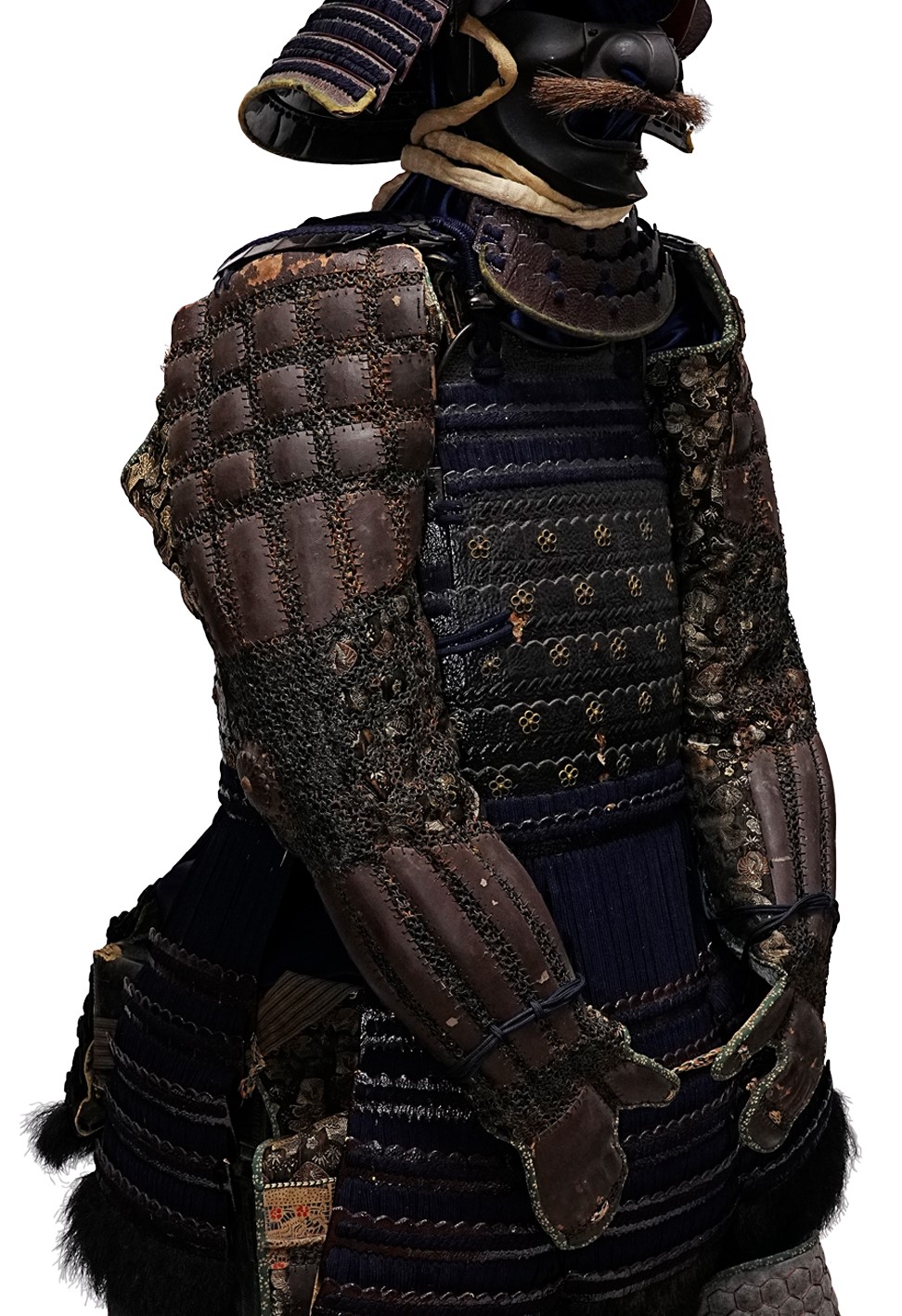

■Haidate (thigh protection):
The Haidate (佩楯) is a thigh guard. Chain mail and iron plates are attached to its cloth. It seems plant-designed clothes are used for this Haidate. For example, a cherry blossom pattern is designed on the fabric used to reinforce the edges.

■Suneate (shin guard):
The Kikkou (亀甲, turtle’s shell) pattern is used for the cloth of the Suneate (脛当). It is a continuous geometric pattern connecting regular hexagons up and down. A theory says that this design was brought from China and the Korean Peninsula during the Asuka (飛鳥, 592-710) and Nara (奈良, 710-794) periods. A proverb says turtles live long lives; therefore, turtle and turtle shell patterns represent longevity. In addition, as this continuous hexagonal pattern does not get out of its shape, it is said people wished for eternal prosperity by using this design.
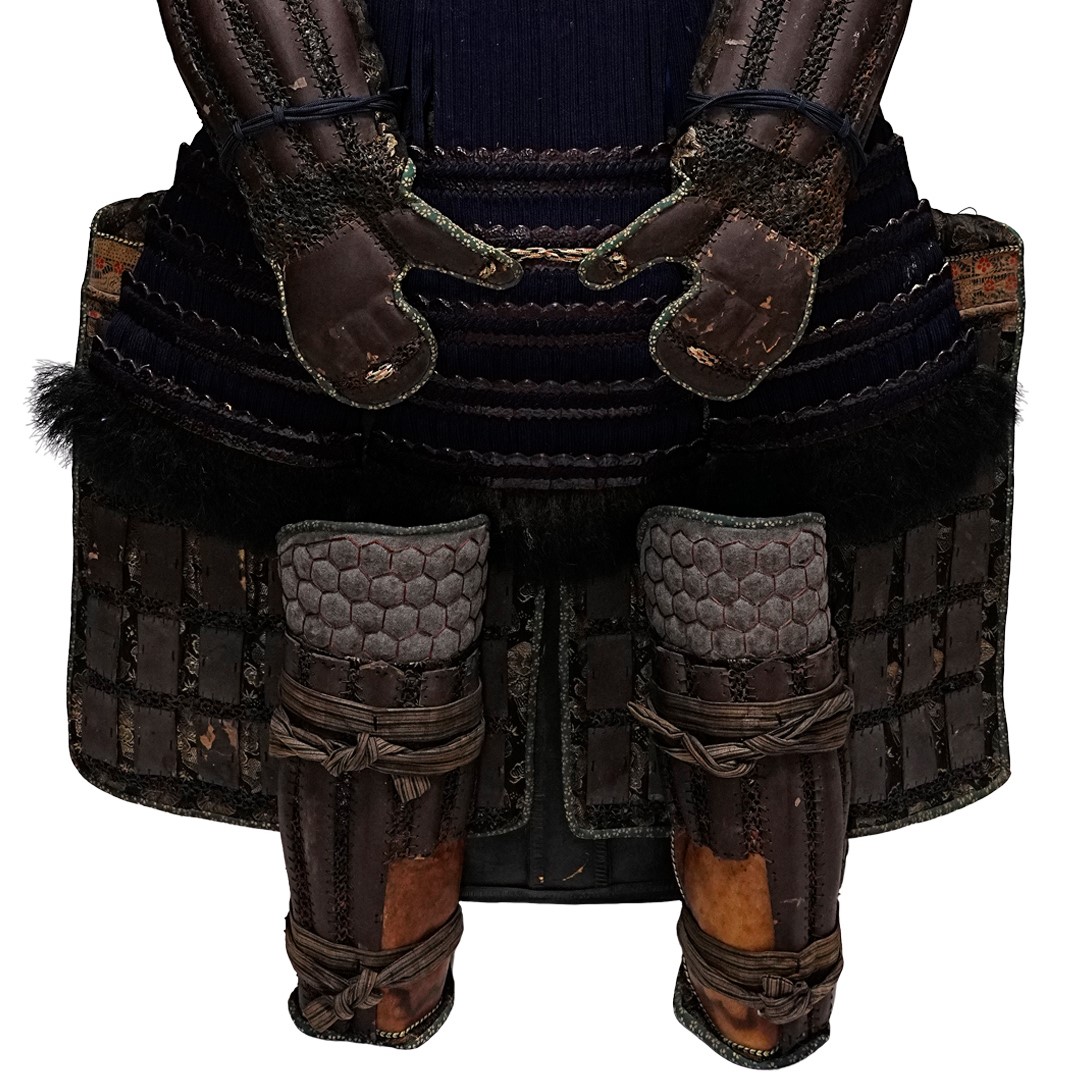
■Gattari (Sashimono holder):
If you focus on the back of this armor, you will find that a ring-shaped metal frame is attached. It is a gear called the Gattari (合当理) that supports the upper part of the Sashimono (指物, a frag or decorative sign installed at the back of armor). And the Uketsutsu (受筒)/ Sashidutsu (指筒) is a tube to store a Sashimono. Samurai warriors judged their sides and enemies on the battlefields by checking the motifs designed for flags. Especially in group battles with infantry, this method was very effective because they could instantly identify affiliations.
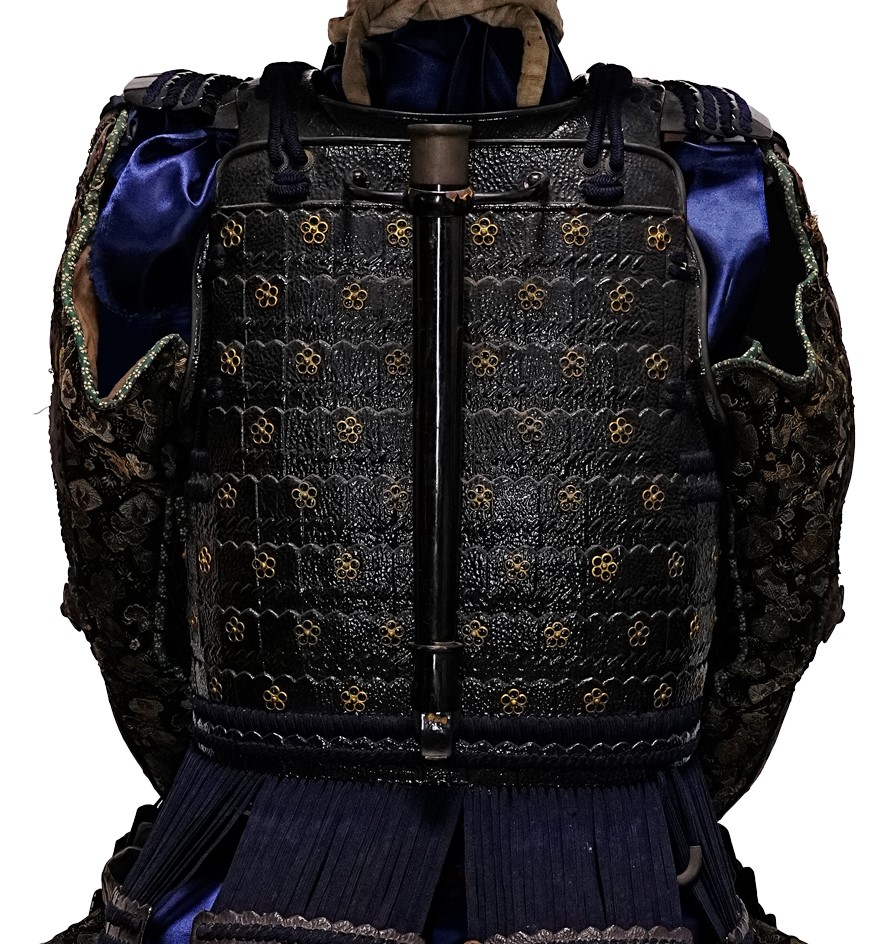

Certification: Tokubetsu Kicho Shiryo Certificate
On August 27th 2023, this armor was appraised as a Tokubetsu Kicho Shiryo by The Association for the Research and Preservation of Japanese Helmets and Armor, which is the most trusted Japanese armor appraiser in Japan. Tokubestu Kicho Shiryo means special rare article. It is ranked as the third highest of five rankings.
The paper mentions the armor was made in the early Edo period (erly-late 17th). You can receive this original authentication paper.

An English translation of the certificate is available on request. We won’t charge any additional fee.
【About us】
Samurai Museum is located in Tokyo, Japan, exhibiting antique artifacts related to the Samurai history. Samurai Museum Shop is the place for those who are interested in Japanese culture and craftsmanship. We deal with antique Samurai swords/armor, traditional crafts made in Japan and so on.
【Antique Japanese Armor and Export process】
After receiving the full payment from you, we will apply for its export permit from the agency for Cultural Affairs to legally export the antique Samurai armor to other countries. It normally takes around 2-4 weeks to receive this permit. And we would like you to expect at least 1-1.5 months for your order to arrive at your given address after you ordered.
【Payment method】
We accept payment through Stripe (Credit card), PayPal, Apple Pay or ChromePay, all of which are secure payment methods. Also, you don’t need to make an account on Stripe for the checkout. If you prefer other payment method, please contact us. You may either pay in JPY, USD, AUD, CAD, EUR, CHF or GBP. The price is set in Japanese Yen. Prices in other currencies are automatically calculated based on the latest exchange rate.

【Shipping duration】
We normally ship via EMS (Express Mail Service) provided by Japan Post. It usually takes at least 5-14 days to deliver the package after you place an order. We offer Free International Shipping as long as we can ship your order by EMS. If you prefer other shipping carriers, please contact us.
We will inform you of the order’s tracking number via email. Please make sure you fill out your valid email address correctly.
*Please keep in mind that due to the spread of COVID-19, there might be possible delays in delivery. If you like to make sure if EMS shipping is available to your country, please contact us.

【How to make sure the condition】
Please keep in mind that what you are going to purchase is an antique item. We uploaded high resolution photos for you to check its condition thoroughly. If you like to see more photos with different angles, please feel free to contact us. We will be happy to send them to you so that you can make informed decision. It is essential for us to know that you are happy with your choice of a sword. and we are prepared to use the best of our ability to serve you.
【How To Contact Us】
Please contact us through email, Facebook Messenger or Live Chat if you have any questions. You can find each icon on the right side of the website. Please click one of them to reach us. We will reply to you within 1-2 business days.
【How To Preserve Antique Samurai Armor】
Dryness, humidity, and bad ventilation might deteriorate the condition of antique Samurai armor. The best temperature to preserve Samurai armor is around 20℃ in Celsius, and humidity should be about 60%. Direct sunlight should be avoided. We recommend storing armors in a room with good ventilation. If you like to display them outside the boxes for a prolonged time, we suggest using a glass case in order for dust not to be accumulated easily. In case you don’t use a glass case, please make sure to regularly dust off from the armor by using a soft brush made of delicate cloth or brush for painting.
If you like to know more about the preservation of this armor, please feel free to contact us.
